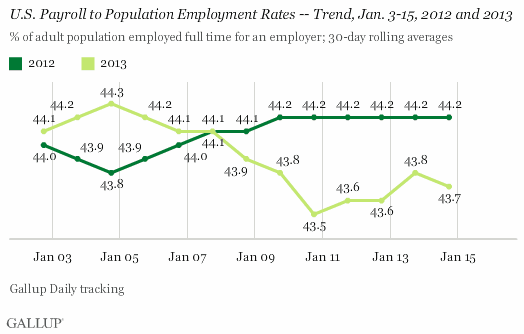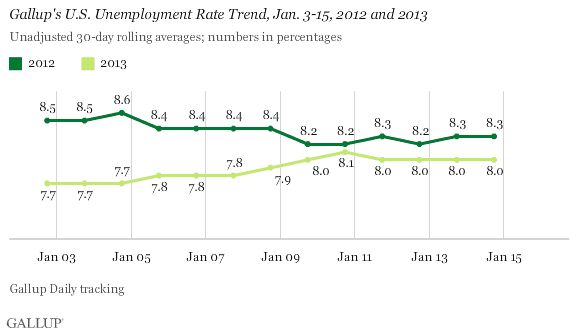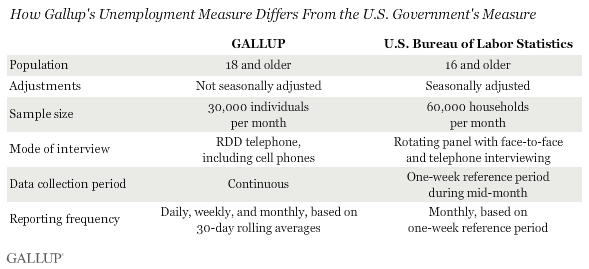WASHINGTON, D.C. -- The U.S. Payroll to Population employment rate (P2P), as measured by Gallup, deteriorated steadily in early January. P2P fell to 43.7% on Jan. 15, based on a 30-day rolling average, from 44.1% for the 30 days ending Jan. 3, the first reading for 2013. The P2P rate is also lower compared with the same time last year, when it was in the low 44% range.

These results are based on Gallup Daily tracking interviews, conducted by landline and cellphone, with approximately 30,000 Americans from Dec. 11-Jan. 15. Gallup's rolling 30-day survey period differs significantly from the reference period the U.S. government's monthly employment reports use, which is one week in the first half of the month.
Unadjusted Unemployment Rate Also Deteriorating
U.S. unemployment, as measured by Gallup without seasonal adjustment, is 8.0% in mid-January, worsening from 7.7% on Jan. 3 and 7.7% for the month of December. However, the unadjusted unemployment rate remains lower than that of January 2012.

Implications
Gallup Daily tracking of the U.S. P2P rate for the 30 days ending on Jan. 15 suggests that the U.S. job market is getting worse in January. While not seasonally adjusted, the P2P shows the job situation is currently worse than it was a year ago.
The declining P2P rate may suggest companies are holding back on hiring, which could be tied to a number of economic concerns, including the coming political battles in the nation's capital over the debt ceiling, sequestration, and the next continuing resolution.
Gallup's P2P rate has an advantage over the government's unemployment measure in that it is not affected by estimates of the size of the labor force or various seasonal adjustments.
Still, Gallup's unadjusted U.S. unemployment rate is also deteriorating in January but the 8.0% in mid-January remains better than the 8.3% in mid-January 2012. Further, Gallup's quality jobs measure -- while still highly negative -- shows that on the margins, the outlook for a quality job is improving. It may be, for example, that in areas that are booming due to new oil production, there are more quality jobs available, even as the jobs situation nationally is getting worse.
The job situation on an unadjusted basis tends to worsen at this time of year. However, Gallup's year-over-year P2P suggests that the current worsening of job conditions involves more than seasonal factors. Whether that will continue or intensify during the remainder of the month remains to be seen.

Gallup.com reports results from these indexes in daily, weekly, and monthly averages and in Gallup.com stories. Complete trend data are always available to view and export in the following charts:
Daily: Employment, Economic Confidence, Job Creation, Consumer Spending
Weekly: Employment, Economic Confidence, Job Creation, Consumer Spending
Read more about Gallup's economic measures.
View our economic release schedule.
Survey Methods
Unemployment and underemployment results are based on telephone interviews conducted as part of Gallup Daily tracking from Dec. 11, 2012-Jan. 15, 2013, with a random sample of more than 30,000 adults, aged 18 and older, living in all 50 U.S. states and the District of Columbia, selected using random-digit-dial sampling.
For results based on the total sample of national adults, one can say with 95% confidence that the maximum margin of sampling error is ±1 percentage point.
Interviews are conducted with respondents on landline telephones and cellular phones, with interviews conducted in Spanish for respondents who are primarily Spanish-speaking. Each sample includes a minimum quota of 500 cellphone respondents and 500 landline respondents per 1,000 national adults, with additional minimum quotas among landline respondents by region. Landline telephone numbers are chosen at random among listed telephone numbers. Cellphone numbers are selected using random-digit-dial methods. Landline respondents are chosen at random within each household on the basis of which member had the most recent birthday.
Samples are weighted by gender, age, race, Hispanic ethnicity, education, region, adults in the household, and phone status (cellphone only/landline only/both, cellphone mostly, and having an unlisted landline number). Demographic weighting targets are based on the March 2012 Current Population Survey figures for the aged 18 and older non-institutionalized population living in U.S. telephone households. All reported margins of sampling error include the computed design effects for weighting and sample design.
In addition to sampling error, question wording and practical difficulties in conducting surveys can introduce error or bias into the findings of public opinion polls.
For more details on Gallup's polling methodology, visit www.gallup.com.
